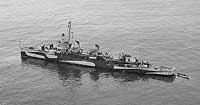
USS William D Porter
The news that the battleship USS Iowa has found a new home brings to mind the story of the battleship and the destroyer USS William D Porter, nicknamed the “Willie D.” The USS Iowa served in World War II as the presidential shuttle in the Atlantic Fleet, moving President Roosevelt to and from the Tehran conference. In November 1943, while the president was aboard the USS Iowa, the battleship came under attack by a live tordepo, accidentally launched from the USS William D Porter. The Iowa was able to avoid the torpedo by taking evasive maneuvers. From that day until she was sunk in June 1945, whenever the Willie D entered port or joined other Naval ships, she was often greeted with “Don’t shoot, we’re Republicans!” (President Franklin Delano Roosevelt was, of course, a Democrat.)
USS William D. Porter (DD-579)
On 12 November, [the USS William D Porter] departed Norfolk to rendezvous with Iowa (BB-61) the following day. That battleship was on her way to North Africa carrying President Franklin D. Roosevelt to the Cairo and Teheran Conferences. Porter was involved in a major mishap while departing Norfolk when her anchor tore the railing and lifeboat mounts off a docked sister destroyer while maneuvering astern. The next day, a depth charge from the deck of Porter fell into the rough sea and exploded, causing Iowa and the other escort ships to take evasive maneuvers under the assumption that the task force had come under torpedo attack by a German U-boat.
On 14 November, at Roosevelt’s request, Iowa conducted an anti-aircraft drill to demonstrate her ability to defend herself. The drill began with the release of a number of balloons for use as targets. While most of these were shot by gunners aboard Iowa, a few of them drifted toward the William D. Porter which shot down balloons as well. The Porter, along with the other escort ships, also demonstrated a torpedo drill by simulating a launch at Iowa. This drill suddenly went awry when the #3 torpedo aboard William D. Porter discharged from its tube and headed toward Iowa.
William D. Porter attempted to signal Iowa about the incoming torpedo but, owing to orders to maintain radio silence, was forced to use a signal lamp. However, the destroyer first misidentified the direction of the torpedo and then relayed the wrong message, informing Iowa that Porter was backing up rather than telling her that a torpedo was in the water. In desperation the destroyer finally broke radio silence, using codewords that relayed a warning message to Iowa regarding the incoming torpedo. After confirming the identity of the destroyer, Iowa turned hard to avoid being hit by the torpedo. Roosevelt, meanwhile, had learned of the incoming torpedo threat and asked his Secret Service attendee to move his wheelchair to the side of the battleship, so he could see.[2] Not long afterward, the torpedo detonated in the ship’s wake some 3,000 yards astern of the Iowa. Iowa was unhurt, but trained her main guns on William D. Porter out of concern that the smaller ship may have been involved in some sort of assassination plot.
Following these events, the William D. Porter’s captain, and her entire crew, were placed under arrest – the first time in U.S. Navy history that this had occurred. The ship and her crew were ordered to Bermuda for an inquiry into the Iowa affair. Lieutenant Commander Walter and several of his officers were sentenced to shore duty. Torpedoman Lawton Dawson, whose failure to remove the torpedo’s primer had enabled it to fire at Iowa, was sentenced to hard labor, though President Roosevelt intervened in his case, as the incident had been an accident.
On 10 June 1945, William D. Porter fell victim to a unique—though fatal—kamikaze attack. At 08:15 that morning, an obsolete Aichi D3A “Val” dive bomber dropped unheralded out of the clouds and made straight for the warship. The destroyer managed to evade the suicide plane, and it splashed down nearby her. Somehow, the explosive-laden plane ended up directly beneath William D. Porter before it exploded. Suddenly, the warship was lifted out of the water and then dropped back again. She lost power and suffered broken steam lines. A number of fires also broke out. For three hours, her crew struggled courageously to put out the fires, repair the damage, and keep the ship afloat. The crew’s efforts, however, availed nought; and, 12 minutes after the order to abandon ship went out, William D. Porter heeled over to starboard and sank by the stern. Miraculously, her crew suffered no fatal injuries. The warship’s name was struck from the Navy list on 11 July 1945.
William D. Porter received four battle stars for her service in World War II.
Richard Miles McCool received the Medal of Honor in part for assisting in rescue of survivors of William D. Porter.
